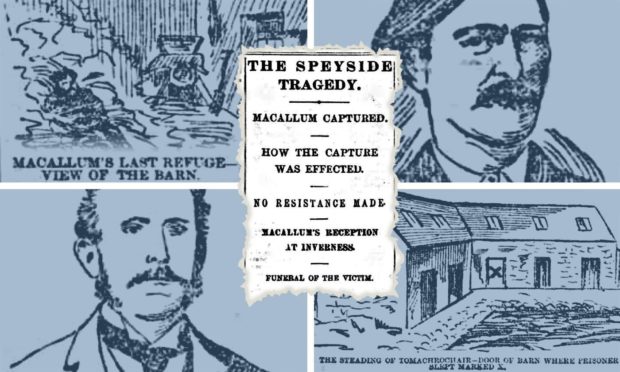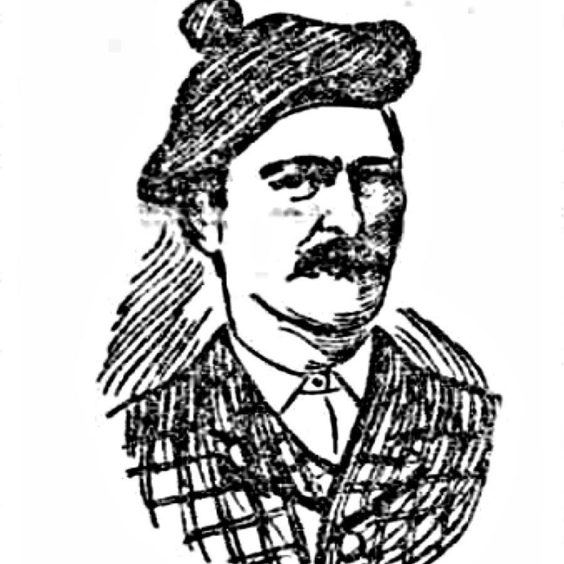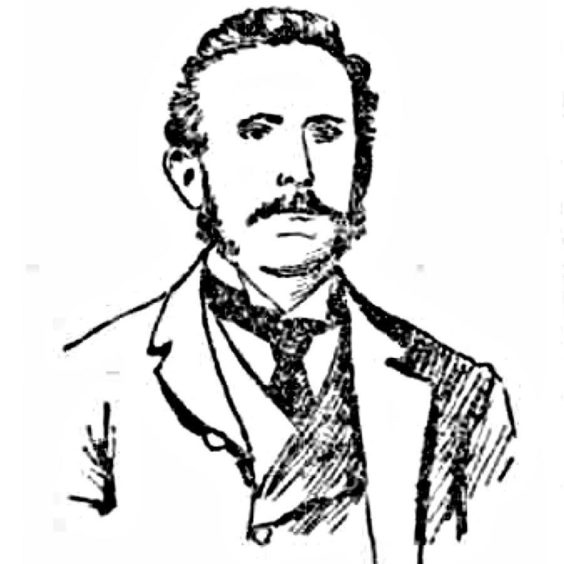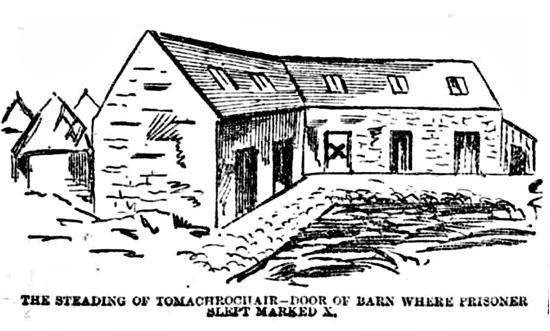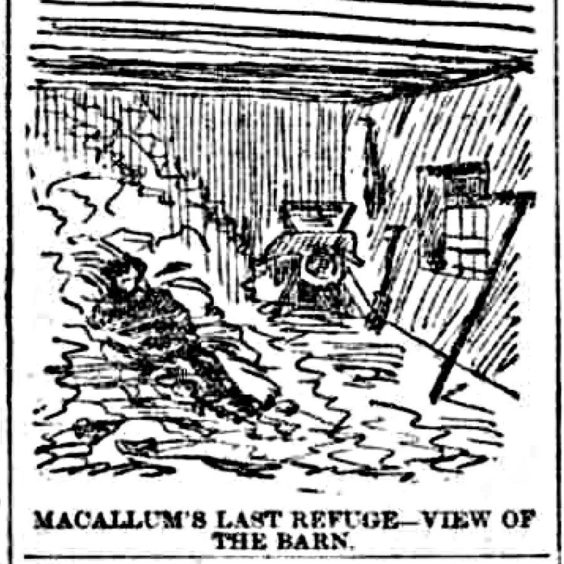It was labelled ‘The Speyside Tragedy’ and shocked the communities around Nethy Bridge to the core in the winter of 1898.
In a row over a signature, notorious local poacher Allan Macallum shot a policeman dead and went on the run before being hunted down by unarmed bobbies on foot and captured.
Macallum, described as 35 years old in one newspaper account and 44 years old in another, turned from ‘wiry Highlander’ at the start of the saga to ‘pitiable and utterly exhausted’ and dressed almost in rags by the end.
Thomas King was his victim, a 46-year-old constable and father of seven, stationed at Nethy Bridge.
Fateful circumstances combined on the morning of December 20, when Constables King and McNiven set out with a warrant to arrest Macallum.
He had ignored a summons to appear before the sheriff in Inverness, so sentence was passed against him, involving a fine or imprisonment.
He didn’t pay the fine, so the unarmed constables were dispatched with the warrant and a document for him to sign.
Macallum had previously been jailed for 90 days for threatening to shoot a gamekeeper, and clearly wasn’t up for going to prison again.
The constables headed to a house in Milton of Tulloch where he lived with a certain May MacPherson and her daughter.
Allan Macallum was ‘dangerous character’
The Aberdeen Journal reported, ‘the two policemen went to the house together, it being a matter of notoriety that in a defiant mood he was rather a dangerous character to deal with’.
May told them Macallum had gone out to get some firewood, and the bobbies waited for about an hour before McNiven set out to look for him, preceded by May, who he feared would try to warn Macallum.
At a sharp bend in the road a shout came from Macallum, who appeared gun in hand, threatening McNiven with a bullet through the heart if he came any further.
McNiven returned that there was no need for such an extreme reaction, and all would be well if Macallum would only sign a certain document.
Macallum high-tailed it at this point shouting that he would fight this time rather than lose his liberty.
He shook off McNiven, who returned to the cottage and met Constable King.
Gunshot heard
There was no sign of Macallum so they decided to pay another visit to the but and ben in the evening.
The Aberdeen Journal reported: “They both went in, King taking the kitchen, McNiven searching the other room, groping about in the darkness when he heard a shot fired.
“It seemed to be outside and he rushed to the door, stumbling in his way over something ‘soft’.
“Outside he met the district postman who told him that he had heard a shot and had seen a figure rush from the back of the house into the plantation.
“MacPherson and her daughter had taken refuge in a neighbouring cottage.
“McNiven returned to the cottage and found his comrade lying at the kitchen door mortally wounded in the breast.
“Macallum’s gun was lying at the feet of his victim.”
McNiven immediately organised a fruitless search party.
Macallum’s dog returned, leading people to think he might have drowned in Loch Garten or escaped on a passing train on the Highland Railway.
The paper reported that he escaped barefoot, in his shirt sleeves.
Body carried home
Joined by a further two policemen, they took King’s body five miles to his home in Nethy Bridge, arriving at about 2am and finding the widow and family in ‘a state of despair’.
They then set a watch on the MacPherson cottage, and headed out on the manhunt.
“The district of Abernethy is as wild and desolate a place as could be found,” reported the Aberdeen Journal.
“The woods are almost impenetrable and the mountains are bare and bleak and contain numerous caves in which one fleeing from justice might find safe retreat, irrespective of the greatest efforts made for his capture.
“But the search party, although they numbered only four were bent on making a determined effort to secure Macallum.
Manhunt
“Two went south and made a thorough search as far as Aviemore, and the other party went in the direction of Tomintoul, climbing the tortuous mountains and scouring the woods.
“Both returned in the [following] evening, perhaps a little fatigued, but thoroughly imbued with the idea that the murderer must be taken before they could rest.
“From the reports they had got in the scattered hamlets they had visited they were quite confident that Macallum would not attempt suicide to elude justice.
“This fact lent inspiration to their enthusiasm and the search was prosecuted with unwonted vigour.”
Important clue as search continues
The following day, four more constables joined the search and got a break.
Angus Grant, a labourer at Clachaig told them a stranger answering Macallum’s description had called at his house late the previous evening.
“On approaching the door, it was said, he asked for a piece of bread as he felt hungry.
“The inmates of the cottage, with true Highland hospitality invited the man to come into the house, but this he declined to do, and they at once brought out some bread.
“On receiving it he asked if the Tulloch assault case was serious.
“The Highland maiden answered that she ‘did not know much about the case’. Probably her suspicions were aroused and she did not like to tell Macallum, who afterwards appeared was the man, the true state of matters.
“This stranger afterwards went off in the direction of Tomintoul but it was thought, might have doubled back towards Tulloch.
“This proved most important as it was the only definite clue which the searchers got of Macallum.”
Next morning, another break, this time conclusive.
A Mr Bell of Tomachrochair farm went to Nethy Bridge police station to tell them Macallum, who had been employed there as a servant previously, had turned up at the farm looking for food and somewhere to lie down for a while.
He was taken to a barn and wearily threw himself down among the straw.
Just as wearily, the police who had now been searching for more than 48 hours virtually without a break, headed for the barn where Macallum gave himself up without a murmur.
“Macallum, when arrested presented a most pitiable spectacle, being dirty and unkempt. He was however subdued and dejected.”
Macallum looked so wretched that he seems to have provoked much pity from those around him after the capture.
“The party walked with the prisoner to the Nethy Bridge Hotel where they offered the poacher some breakfast, but he ate sparingly and kept up his sullen mood.
“In appearance he was haggard and worn and he seemed to have suffered much privation.
“His clothes were worn and patched and his appearance betokened one who had led a hard nomadic life.”
Macallum even turned down a dram from the hotel keeper, but one newspaper reported that he was “so much touched with kind offer that he completely broke down and cried bitterly”.
In their reports, the papers made much of the name of the farm – Tomachrochair being Gaelic for Hangman’s Knoll.
Macallum was one of a handful of well known ‘blackguards’ who had got away with terrorising the district for years.
The papers demanded an inquiry into how this could have been allowed.
Meanwhile, stories emerged about Macallum’s past in ‘the colonies’.
In prison he had talked about his experiences as a backswoodsman and cowboy in America and Australia, boasting about being well-armed and making good use of his weapons when occasion required.
He had also spent time in the Straits of Magellan and when he came back he was much changed according to his brother Donald, a gamekeeper at Inch, Kingussie.
He appears to have contracted an illness there which gave him pains in the head and violent mood swings.
Terror of gamekeepers
Donald, reported the press, had objected to his brother’s barefaced poaching on his master’s estate and ordered him off, after which he “settled down in earnest to the avocation of poacher. He had studied where to get the best market for his spoil and many game dealers throughout the kingdom are familiar with his name.
“In the wild mountains and wooded district known as Monadhliath the clever agile and daring poacher outwitted the closest espionage of keepers for years.
“He was the terror of the gamekeepers around and latterly they have permitted him to roam pretty much unmolested. His only companion was his dog.”
His sanity had been questioned in previous years, but in court, doctors vouchsafed that he was perfectly sane, possibly suffering from ‘melancholia’ not ‘mania’.
He was found guilty of culpable homicide and sentenced to 15 years penal servitude, being released after 11 years.
Meanwhile a collection was made for Constable Thomas King’s widow, Jessie Gordon formerly of Botriphie.
She and the seven children emigrated to Australia between 1906 and 1909, where many descendants are still alive, one even making a career with the police service in Queensland.
Constable King’s funeral
The Aberdeen Journal’s ‘special reporter’ gave a vivid account of King’s funeral, pointing out it was going on just as Macallum was captured.
“Men from the Moray, Kingussie, Beauly, Errogie, Boat of Garten, Ardersier, Lentran, Aviemore, Tomatin and Daviot attended, forming a guard of honour.
“Others would have been there but were out searching.
“Seafield estate staff were present and a large concourse of people from the district.
“The cortege formed one of the largest ever seen in Abernethy.
“Rev Dr Forsyth, Abernethy conducted the service at the house, coffin, Thomas King aged 46 years was carried out and laid on chairs in front of the house where the service was conducted.
Poignant reading
“Dr Forsyth read a passage of scripture which the deceased constable had read to his wife and family on the morning of his tragic death.
“Prayer having also been offered, the procession was formed.
“In front walked the constables in pairs and the comrades of the deceased carried the coffin on their shoulders to the grave.
“The spectacle presented as the funeral procession passed on with slow and solemn tread was of the most impressive character.
“Arrived at the churchyard, the ranks of the constables in front opened and the remains of their comrade were saluted as they were borne to the grave.
When the coffin was lowered, the whole gathering appeared much affected.
“The children in the public school were not called upon to return in the afternoon and the village exhibited every outward sign of mourning.”
You might enjoy:
Looking back on the first day of school for north-east pupils
